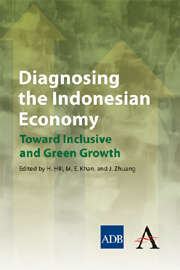Book contents
- Frontmatter
- Foreword
- Preface
- Author Profiles
- Abbreviations and Acronyms
- Contents
- 1 Introduction
- 2 Development Policies and Performance
- 3 Critical Constraints to Growth
- 4 Critical Constraints to Reducing Poverty and Inequality
- 5 Macroeconomic Management
- 6 Industrialization: Patterns, Issues, and Constraints
- 7 Infrastructure Development: Challenges and the Way Forward
- 8 Human Capital and Economic Development
- 9 Economic Growth, Employment Creation, and Poverty Alleviation
- 10 Poverty Reduction: The Track Record and Way Forward
- 11 Decentralization
- 12 Making Indonesia's Growth Green and Resilient
- Index
4 - Critical Constraints to Reducing Poverty and Inequality
Published online by Cambridge University Press: 05 May 2012
- Frontmatter
- Foreword
- Preface
- Author Profiles
- Abbreviations and Acronyms
- Contents
- 1 Introduction
- 2 Development Policies and Performance
- 3 Critical Constraints to Growth
- 4 Critical Constraints to Reducing Poverty and Inequality
- 5 Macroeconomic Management
- 6 Industrialization: Patterns, Issues, and Constraints
- 7 Infrastructure Development: Challenges and the Way Forward
- 8 Human Capital and Economic Development
- 9 Economic Growth, Employment Creation, and Poverty Alleviation
- 10 Poverty Reduction: The Track Record and Way Forward
- 11 Decentralization
- 12 Making Indonesia's Growth Green and Resilient
- Index
Summary
Poverty in Indonesia declined significantly during the two decades prior to the 1997 Asian financial crisis (AFC), when the poverty rate surged. The poverty rate has again been decreasing steadily since the crisis. Geographical disparity is an important aspect of poverty in Indonesia, with the poverty headcount rate for Maluku, Papua, and Nusa Tenggara remaining about three times that for Kalimantan. Another important feature of poverty in Indonesia is the dense cluster of population around the poverty line, indicating the vulnerability of Indonesian households to poverty. These observations underline a need for enhancing inclusive growth in order to reduce poverty and inequality. This chapter identifies potential constraints to the inclusiveness of growth using the conceptual framework outlined in Chapter 1.
Trends in Poverty and Inequality
Poverty
Indonesia's poverty fell significantly during 1976–1996, with the poverty incidence declining from about 40.1% to 11.3% (Figure 4.1). In 1996, the methodology for poverty estimation was revised, and the poverty incidence was estimated at 17.7% based on the new definition. The poverty incidence then shot up to 24.2% in 1998 due to the 1997 AFC. Six years elapsed before the poverty incidence moved below the pre-crisis levels. The poverty incidence then again rose, from 16.7% in 2005 to about 17.8% in 2006 due to the surge in rice prices (World Bank 2006a).
- Type
- Chapter
- Information
- Diagnosing the Indonesian EconomyToward Inclusive and Green Growth, pp. 87 - 148Publisher: Anthem PressPrint publication year: 2012



